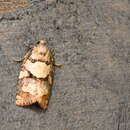Conservation Status
provided by University of Alberta Museums
Uncommon, but not of concern.
- license
- cc-by-nc
- copyright
- University of Alberta Museums
Cyclicity
provided by University of Alberta Museums
Early July to mid August in Alberta.
- license
- cc-by-nc
- copyright
- University of Alberta Museums
Distribution
provided by University of Alberta Museums
Anywhere spruce grows in Alberta, transcontinental across boreal Canada and south through the mountains to Utah.
- license
- cc-by-nc
- copyright
- University of Alberta Museums
General Description
provided by University of Alberta Museums
The forewing is light grey to pinkish grey with traces of thin dark lines. There are distinctive bands that are brown to grey and are edged by black lines. The hindwing is yellowish with fine darker grey reticulations.
The larva is greyish green to cream coloured with a black head and thoracic shield (Duncan 2006).
- license
- cc-by-nc
- copyright
- University of Alberta Museums
Habitat
provided by University of Alberta Museums
Coniferous forest.
- license
- cc-by-nc
- copyright
- University of Alberta Museums
Life Cycle
provided by University of Alberta Museums
Archips alberta is a solitary defoliator that can cause some cone crop damage. The larva overwinters in the first instar and in the spring resumes mining needles and webs adjacent needles together. Later instars feed on foliage and cones, often with considerable webbing where it often later pupates in June. Adults frequent lights and eggs are typically laid in the dense crowns of Black Spruce. (Duncan 2006)
- license
- cc-by-nc
- copyright
- University of Alberta Museums
Trophic Strategy
provided by University of Alberta Museums
The larva mainly feeds on Black Spruce (Picea mariana), but also White Spruce (Picea glauca) and Engelmann Spruce (Picea engelmannii) foliage and cones (Freeman 1958; MacKay 1962; Razowski 1977; Duncan 2006).
- license
- cc-by-nc
- copyright
- University of Alberta Museums

